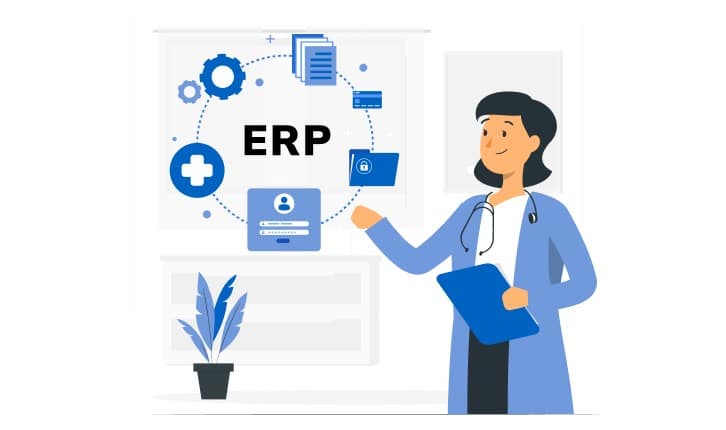Healthcare ERP, an abbreviation for Enterprise Resource Planning, is reshaping the landscape of healthcare management. In this article, we’ll explore the definition, evolution, key features, benefits, challenges, successful implementations, future trends, and insights on selecting the right Healthcare system.
Evolution of Healthcare ERP

Healthcare has always faced unique challenges in managing patient data, financial processes, and supply chains. The integration of ERP systems marks a pivotal shift, addressing historical challenges and providing a comprehensive solution to streamline healthcare management.
Key Features of Healthcare ERP
Patient Data Management
Efficient patient data management is at the core of Healthcare ERP. The system centralizes patient records, ensuring quick access to information, reducing errors, and facilitating seamless collaboration among healthcare professionals.
Streamlined Billing and Financial Processes
Healthcare brings efficiency to billing and financial processes. From insurance claims to billing accuracy, the system automates financial workflows, reducing administrative burdens and improving revenue cycle management.
Inventory and Supply Chain Management
Ensuring the availability of medical supplies is critical in healthcare. ERP manages inventory levels, tracks supply chains, and minimizes the risk of shortages, ensuring timely and efficient healthcare services.
Benefits of Implementing Healthcare ERP
Improved Patient Care
Healthcare enhances the quality of patient care by providing quick access to accurate patient data, reducing wait times, and facilitating better communication among healthcare providers.
Enhanced Operational Efficiency
By automating administrative and financial processes, ERP improves operational efficiency. This allows healthcare professionals to focus more on patient care and less on paperwork.
Regulatory Compliance
In the highly regulated healthcare industry, compliance is paramount. Healthcare systems help organizations adhere to regulatory standards, reducing the risk of penalties and ensuring the highest standards of care.
Challenges in Implementing Healthcare ERP
Data Security Concerns
Healthcare deals with sensitive patient information, raising concerns about data security. Implementation must include robust security measures to protect patient privacy and comply with healthcare data regulations.
Staff Training and Adoption
The successful adoption of requires thorough training for healthcare staff. The learning curve can be steep, and ongoing support is essential to ensure that users can navigate and utilize the system effectively.
Customization Challenges
Every healthcare institution has unique processes. Healthcare ERP systems must strike a balance between standard features and customizable solutions to cater to the specific needs of each organization.
Case Studies: Successful Healthcare ERP Implementations
Hospital A: Optimizing Patient Care
Hospital A implemented ERP, resulting in a 20% reduction in patient wait times. The system’s centralized data management and streamlined processes significantly improved overall patient care.
Clinic B: Streamlining Administrative Processes
Clinic B adopted Healthcare , leading to a 30% reduction in administrative workload. The system’s automation of billing and financial processes allowed staff to focus more on patient interactions.
Future Trends in Healthcare ERP
Integration of Telemedicine
The future of Healthcare involves seamless integration with telemedicine platforms. This integration will enable healthcare providers to offer a more comprehensive and accessible range of services.
AI and Predictive Analytics
Artificial Intelligence (AI) and predictive analytics will play a significant role in Healthcare. These technologies will enhance diagnostic accuracy, treatment planning, and overall healthcare decision-making.
Selecting the Right Healthcare ERP System
Scalability
Choosing a scalable Healthcare system is crucial for adapting to the evolving needs of healthcare institutions. The system should be able to accommodate growth in patient volumes and expanding service offerings.
Interoperability with Existing Systems
Integration with existing healthcare systems is essential for a smooth transition to Healthcare ERP. Ensuring interoperability facilitates a cohesive approach to healthcare management.
Realizing the Full Potential of Healthcare ERP
Change Management Strategies
Successful adoption of Healthcare requires effective change management. Healthcare institutions should communicate the benefits of the system, provide necessary resources, and support staff through the transition.
Continuous Improvement
ERP is not a one-time solution but a continuous improvement process. Institutions should gather feedback, stay updated on technological advancements, and incorporate improvements to maximize the benefits of the system.
Conclusion
In conclusion, Healthcare is not just a tool; it’s a catalyst for positive change in healthcare management. Its impact on patient care, operational efficiency, and compliance is transformative. As healthcare institutions navigate the complexities of modern healthcare, embracing ERP becomes not just a choice but a strategic investment in the future of healthcare.
[adinserter block=”1″]